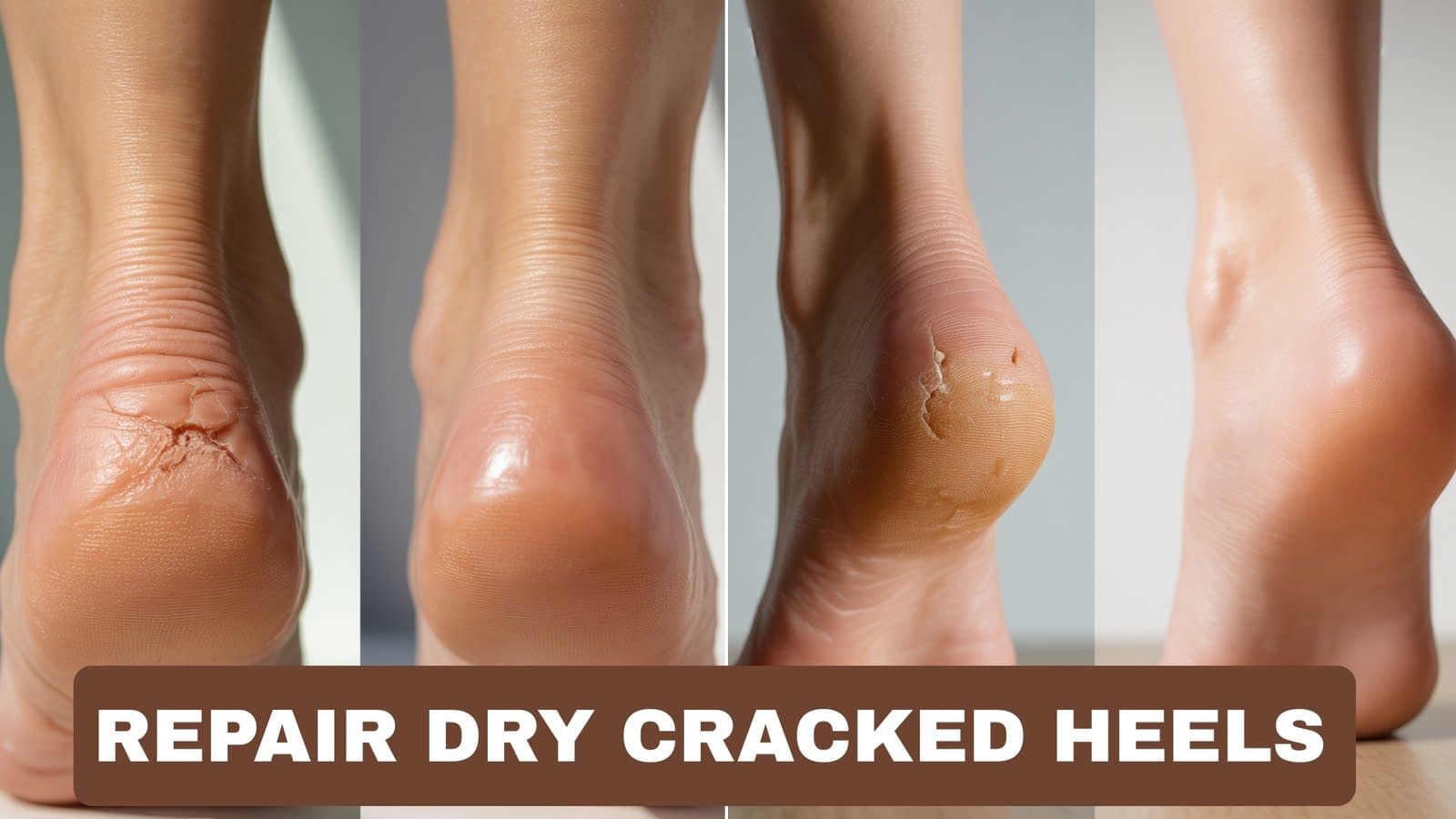You want smooth legs without the raspberry-strawberry-stubble effect, razor burn, or mystery red bumps that look like tiny campfires. Fine. Shaving is simple — and also something people ruin every single day by rushing, using the wrong tools, or treating their skin like a car you never change the oil on. Below is a thorough, practical, step-by-step guide that covers prep, tools, technique, nicks, aftercare, and how shaving stacks against other hair-removal options. Read it, do the steps, and your legs will behave.
Prep Your Skin: The Secret to a Smooth Shave
Shaving isn’t a surface thing — it’s a conditioned-skin thing. Proper prep = fewer cuts, closer shave, less irritation.
Step-by-step prep routine
- Clean first. Rinse legs or shower for at least 3–5 minutes with warm water to remove dirt, sweat, and body oil. Cleansing prevents bacteria getting dragged across the skin while you shave.
- Soften hairs. Warm water softens and lifts hairs and opens pores. Do it in the shower or use a warm compress for 3–5 minutes if you’re rushing.
- Trim if needed. If your hair is longer than ~¼ inch (think after a few weeks), trim with scissors or an electric trimmer so the razor glides more easily and won’t clog.
- Apply pre-shave oil (optional). If you’re prone to razor burn, a thin layer of pre-shave oil before cream adds glide. Use sparingly — too much oil interferes with lather.
- Map trouble zones. Notice bumps, moles, or raw patches and avoid shaving directly over irritated skin; treat first.
Why it helps: softened hair + clean skin = smoother cuts and less tugging. That reduces helicopter-blade chaos.
Choose the Right Razor for the Job
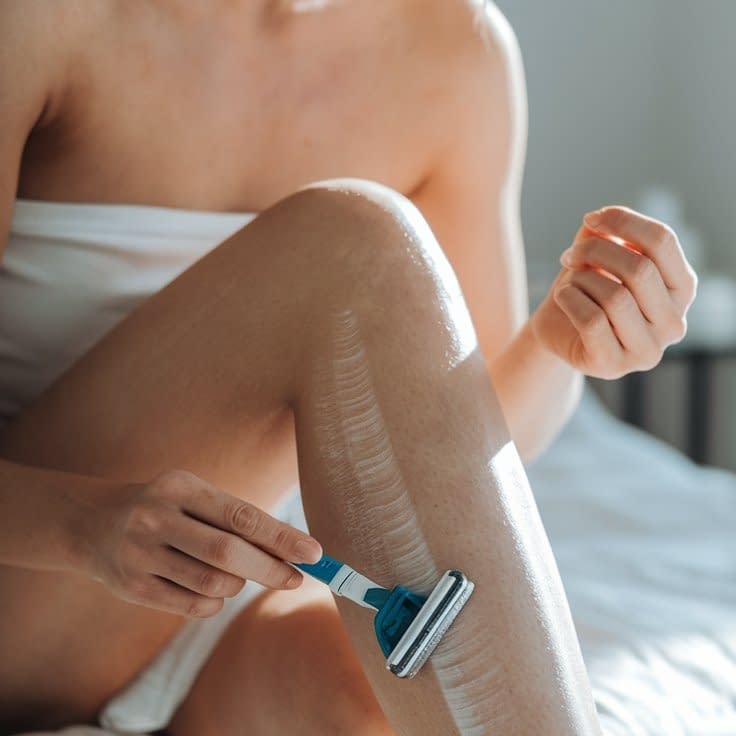
A razor is not a razor. Pick the right tool and half your problems vanish.
Razor options & how to choose
- Disposable multi-blade cartridge razors: Convenient and common. Great for quick shaves but can clog and promote ingrown hairs for some people if used aggressively. Replace blades regularly.
- Safety razor (single blade): Closer, cleaner cut with less irritation for many people because one blade cuts hair once instead of repeatedly tugging. Requires learning angle and pressure. Cheaper long-term and less wasteful.
- Electric foil/rotary shavers: Fast, dry-shave option. Gentle and low-risk for cuts, but not as close as wet shaving. Good for sensitive skin or quick touch-ups.
- Epilators/depilatory devices: Not razors, but worth noting — painful but long-lasting. See section 12 for comparisons.
How to pick:
- If you’re new and want convenience, start with a multi-blade cartridge and good technique.
- If you get ingrowns or razor burn frequently, try a safety razor — single-blade reduces follicle trauma.
- If time is king and you dislike wet routines, consider an electric shaver.
Replace blades: see section 11. Don’t be sentimental about a dull blade.
Soften Hair Before You Shave
Yes, more softening. Hair that’s relaxed shaves easier and less painfully.
Softening routine (step-by-step)
- Shower or soak: Warm shower for 5–10 minutes or soak legs in warm water for 3–5 minutes.
- Use a moisturizing cleanser: A gentle body wash hydrates the hair and gives initial slip. Avoid harsh soaps that strip moisture.
- Optional: apply a warm, damp towel for 1–2 minutes to especially coarse hair areas right before shaving.
Result: blade glides, less tugging, less microtearing. Your legs will thank you — quietly.
Exfoliate Gently to Avoid Ingrown Hairs
Dead skin = trap for hair and cause of ingrown hairs. Exfoliate smartly, not aggressively.
Exfoliation plan (step-by-step)
- When: Exfoliate 1–2 times per week. Don’t scrub right before shaving if your skin is sensitive — do it the night before or a day prior.
- How: Use a gentle scrub with round, smooth particles or a soft brush/konjac sponge. For chemical options, a mild AHA (lactic) product 1–2x weekly works well.
- Be gentle: Use light pressure; move in circles; don’t overdo it.
- Post-exfoliation: Hydrate skin immediately afterward to prevent barrier damage.
Why file: exfoliation frees trapped hairs and smooths the skin so hair grows out without curling back into the follicle.
Use the Right Shaving Cream (Not Just Soap)
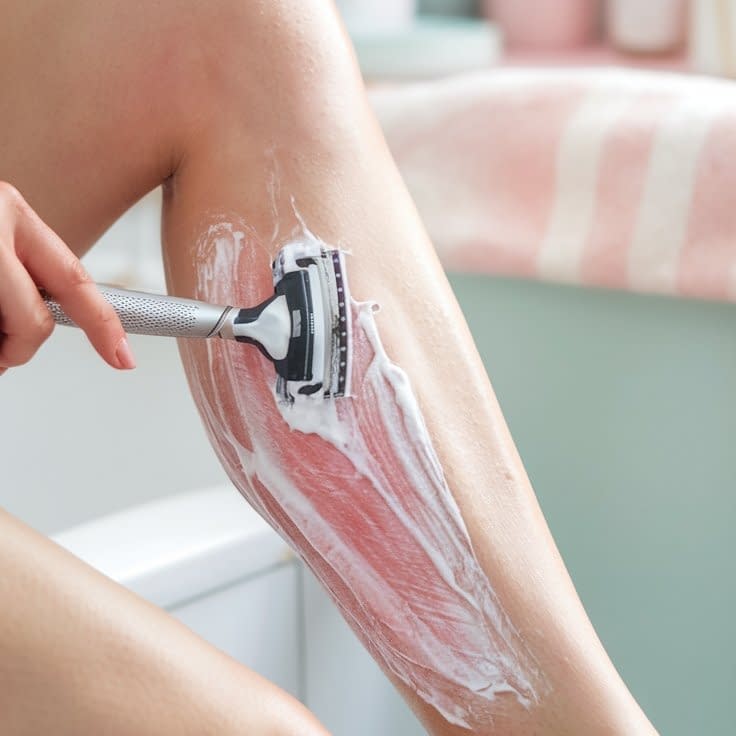
Soap is lazy and drying. Use a product that supports cushion, glide, and hydration.
Shaving product options & how to use them
- Shaving cream/gel: Classic. Creates protective lather. Look for moisturizing ingredients (glycerin, aloe) and minimal fragrance.
- Shaving soap & brush: Luxurious, better for eco-leaning folks; the brush lifts hairs and produces slick lather.
- Shaving oil: Great for sensitive skin — slickest of all and reduces friction. Use alone or under cream.
- Conditioner or body lotion (in a pinch): Better than nothing, but not ideal for glide.
Step-by-step application
- Apply liberally: Don’t sting for coverage.
- Let it sit 30–60 seconds for extra softening before you start shaving.
- Reapply to areas you go over more than once. Don’t dry out the skin mid-shave.
Avoid aerosol cans with alcohol if your skin is sensitive — they dry.
Master the Shaving Technique: Direction Matters
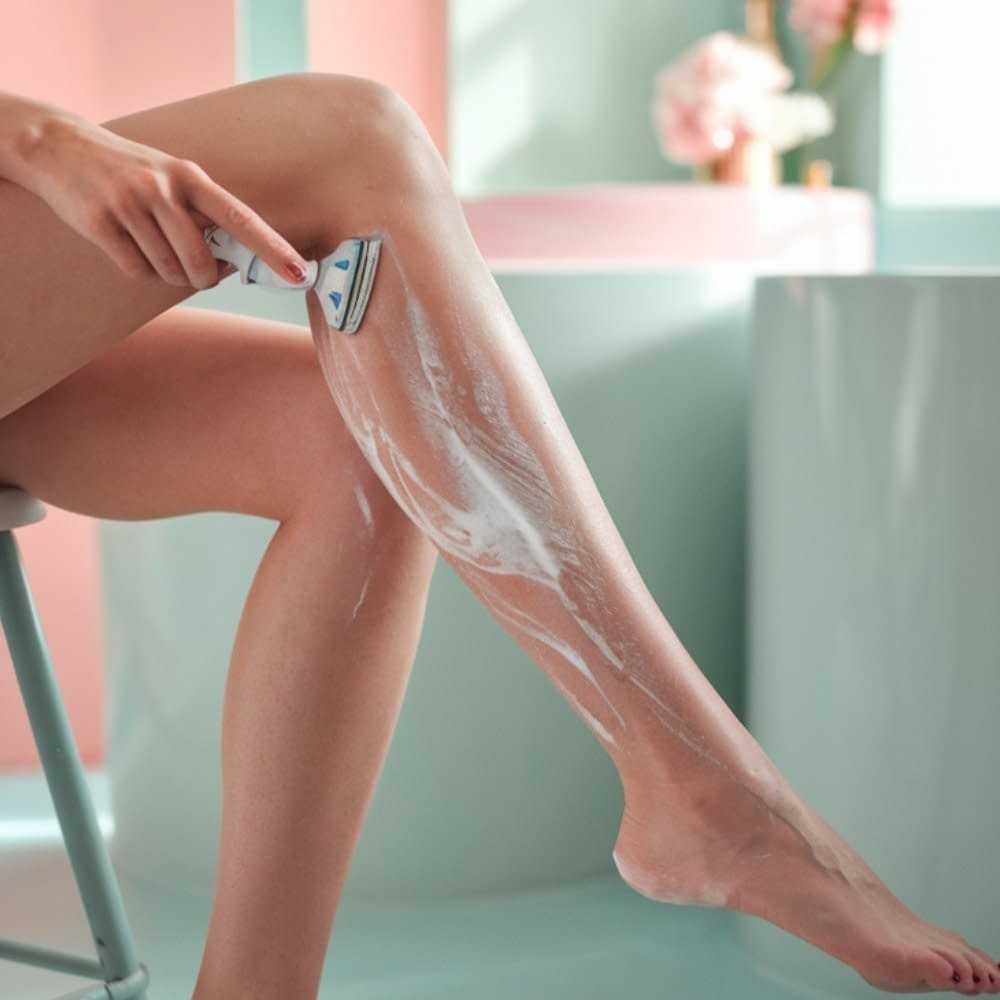
Technique > force. Learn the angles and you’ll reduce irritation dramatically.
Shaving technique (step-by-step)
- Start with the grain: Shave in the direction the hair grows for first pass. This reduces irritation. For most legs, that’s downward on the front, varying on the sides — inspect the grain.
- Use short, light strokes: Don’t attempt a skyscraper stroke. Small, controlled passes let the blade do the work.
- Keep the blade flat: Hold the razor at a shallow angle (~30° if using a safety razor; cartridge makers sometimes recommend different angles) and use light pressure. Pressure equals irritation.
- Rinse the blade between strokes (see section 7).
- If you need a closer shave: Reapply cream and do one gentle pass across or slightly against the grain — only if your skin tolerates it and you’re not prone to ingrown hairs. For sensitive skin, avoid against-the-grain passes.
- Go slow in tricky areas: Ankles, knees, and behind the knees need acute attention — flex the joint, hold skin taut, and take tiny strokes.
Remember: less pressure, more glide. If you shave aggressively, you’re asking for razor burn.
Rinse Your Razor Often for a Cleaner Glide
A clogged blade = tugging, dragging, and eventual nicks. Rinse frequently.
How to rinse properly
- After every stroke or two, hold the razor under warm running water and tap gently to remove hair and cream.
- If the blade clogs, use a soft brush to clear it — avoid poking between blades where it’s sharp.
- Shake lightly and store in a dry place (not on a wet shower shelf) to reduce rust and bacterial growth.
Tip: Don’t dunk your razor into stagnant water or a soap dish full of gunk. Clean blades last longer and cut better.
Treat Nicks and Cuts the Right Way
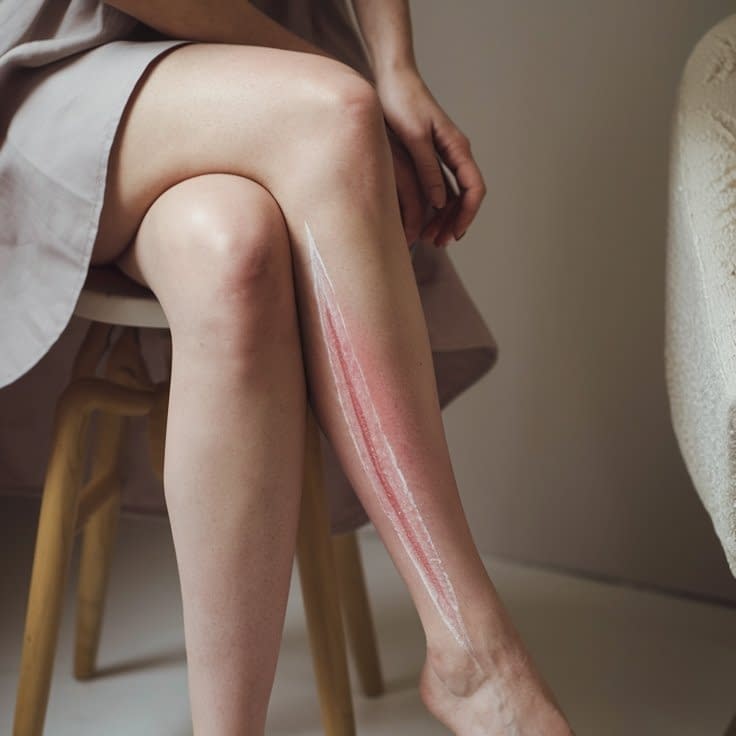
You will nick yourself. Don’t panic. Treat it quickly and smartly.
First-aid for shaving cuts (step-by-step)
- Apply pressure: Use a clean tissue or cloth and hold steady until bleeding slows.
- Stop the bleeding: Apply a styptic pencil or alum block if you have one. These are tiny lifesavers for frequent shavers. Alternatives: a moistened tea bag pressed for a minute (tannins help) or cornstarch to clot.
- Clean & protect: Rinse with cool water, pat dry, and if needed apply a small amount of antibiotic ointment or petroleum jelly to keep it moist and prevent scab cracking. Cover with a small adhesive bandage if it’s likely to rub on clothing.
- Avoid picking: Let it heal. Picking increases scarring risk.
If a cut is deep, won’t stop bleeding, or shows signs of infection (increasing redness, pus, spreading warmth), see a healthcare provider.
Post-Shave Care: Lock In Moisture for Silky Legs
The aftercare is not optional. This is where smooth legs stay smooth.
Post-shave routine (step-by-step)
- Rinse with cool water: A quick cool rinse closes pores and soothes. Don’t ice — just cool lukewarm to cool.
- Pat dry, leave slightly damp: As with the towel-off trick, apply products to damp skin.
- Apply a gentle, fragrance-free moisturizer or oil: Look for glycerin, hyaluronic acid, ceramides, squalane, or shea butter. For very sensitive legs, a no-fragrance lotion is best.
- Use a light, calming product if irritated: Aloe vera gel or a cream with niacinamide helps calm redness and builds barrier strength.
- Avoid tight clothes immediately post-shave: Give skin an hour or so before tight leggings to prevent follicular irritation.
- If you get bumps or ingrowns: Use a targeted product with 0.5–2% salicylic acid or a glycolic cleanser nightly to prevent buildup. For severe ingrowns, see a dermatologist.
Routine timing matters: hydrate within minutes of drying to seal moisture.
Avoiding Razor Burn: Tips for Sensitive Skin
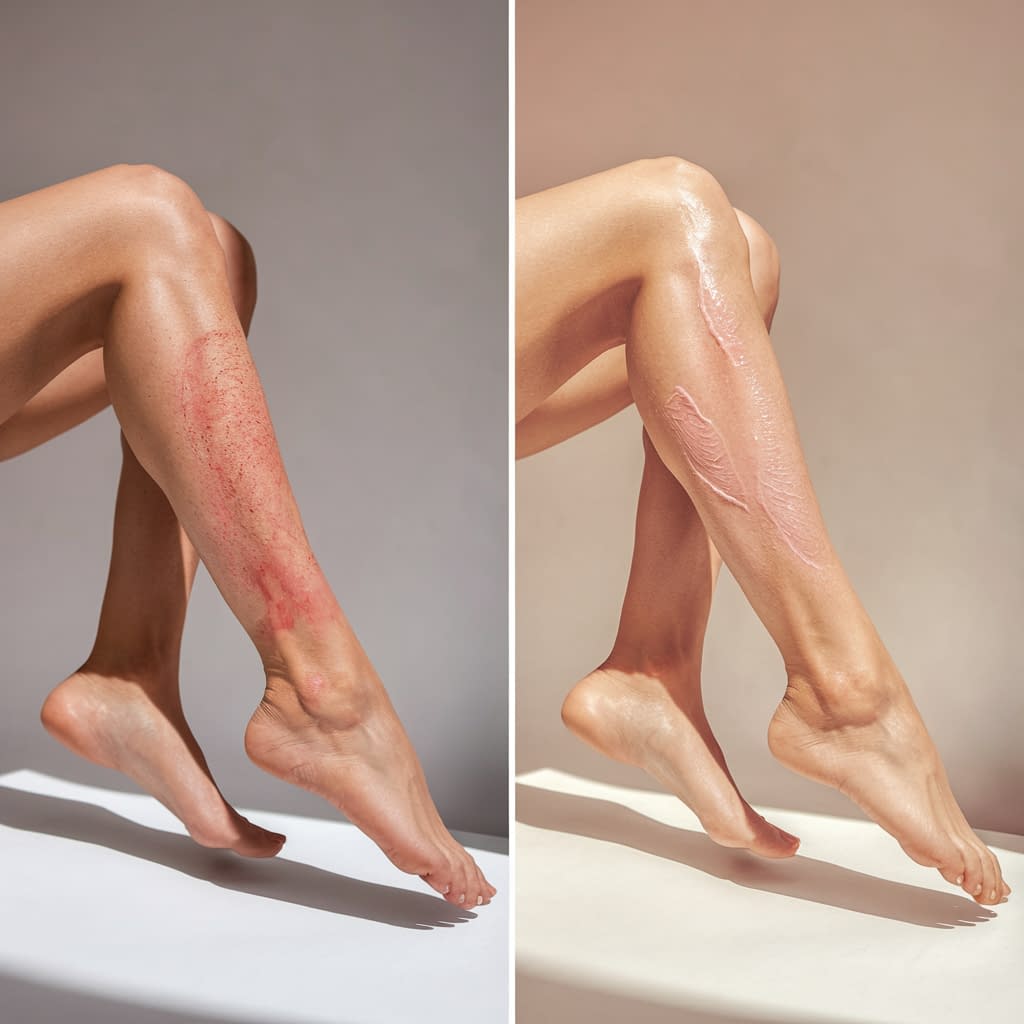
Razor burn is preventable. It’s basically friction + inflammation — fix the friction, calm inflammation.
Prevention strategy (step-by-step)
- Use a sharp blade (dull = burn). Replace regularly.
- Hydrate and lather like in sections 1–5.
- Don’t tug or stretch skin excessively. Keep skin taut only where needed.
- Shave with the grain for sensitive areas; skip against-the-grain passes.
- Use minimal pressure. Let the blade glide.
- Post-shave, apply a calming lotion with aloe, panthenol, or niacinamide. Avoid alcohol-based aftershaves — they sting and dry.
- If you get burn: Stop shaving that area for a day or two. Apply a thin layer of petroleum jelly or a steroid-free anti-itch cream until it settles.
If irritation persists despite best practice, try switching razor type (cartridge → safety razor → electric) and change shaving frequency.
When to Replace Your Razor Blade
Timing for blade replacement is simple: replace when performance drops, not when you get sentimental.
How to tell it’s time
- It drags or tugs. That’s the first and loudest sign.
- You need multiple passes to get the same result.
- Irritation increases with the same technique/products.
- Visible rust or corrosion on the blade.
- Blades are old and have been stored wet — replace sooner.
Practical replacement schedule
- Disposable cartridges: 5–10 shaves per person is a general range; oily, coarse hair wears blades faster. Replace sooner if you feel drag.
- Safety razor blades: Often last 3–8 shaves depending on coarseness of hair and blade quality; cheap blades vary. Rotate brands and track how they feel.
- Electric shavers: Replace foils and cutters per manufacturer schedule (roughly every 12–18 months) or when performance drops.
Rule: a sharp blade is kinder to skin than a dull one. Stop economizing on the thing that touches your skin.
Shaving vs. Other Hair-Removal Methods: What’s Best for You?
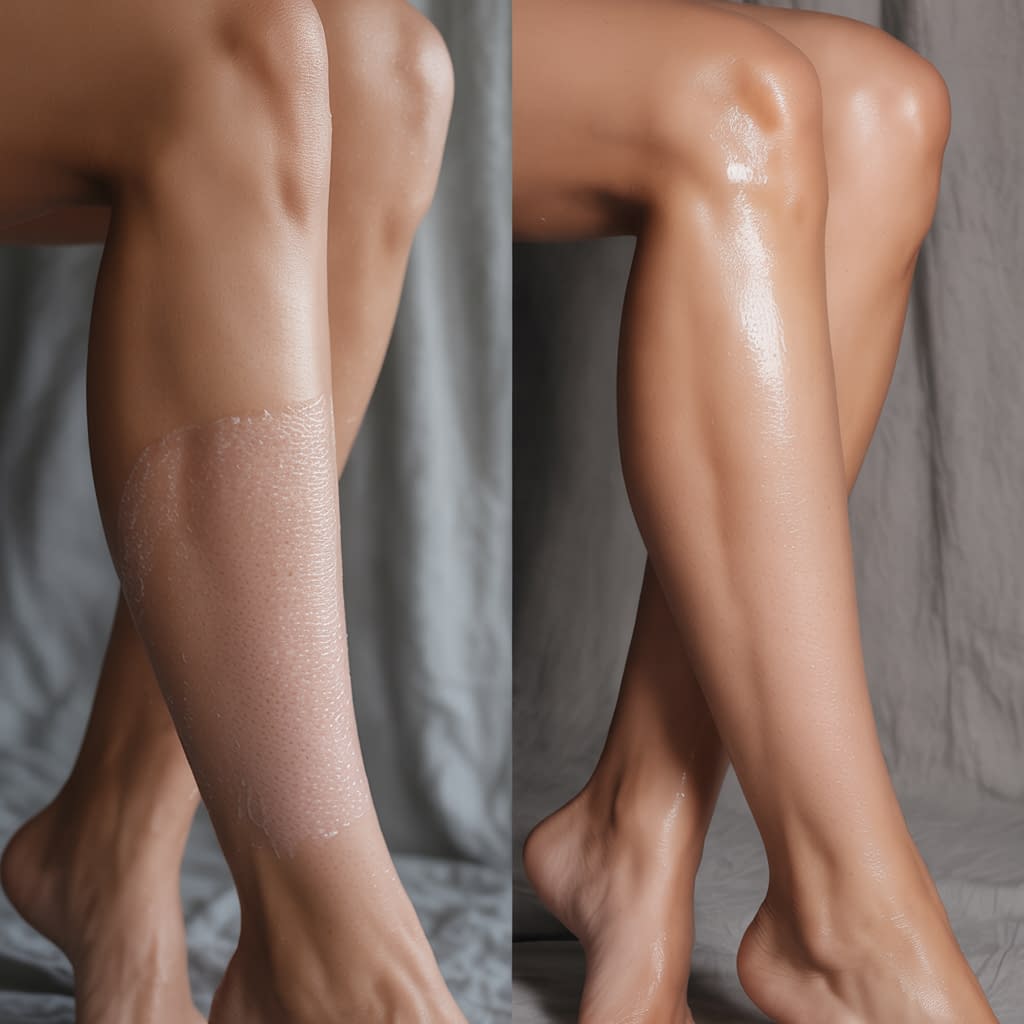
Shaving is fast and cheap, but not the only game. Here’s how other methods stack up so you can choose without buyer’s remorse.
Comparison overview
- Shaving
- Pros: quick, inexpensive, minimal pain, no waiting for regrowth.
- Cons: regrowth appears in days, risk of cuts/ingrown hairs, frequent maintenance.
- Best for: those who want control and immediate results with low cost.
- Waxing
- Pros: lasts 3–6 weeks, hair grows back finer for some people.
- Cons: painful, can irritate sensitive skin, requires hair to be a certain length, can cause ingrowns.
- Best for: long-lasting smoothness and patience for the pain.
- Sugaring
- Pros: similar to waxing, often gentler; less heat; natural pastes.
- Cons: same regrowth period, skill-dependent.
- Best for: those wanting waxing results with slightly less irritation.
- Depilatory creams (chemical)
- Pros: painless, quick, inexpensive.
- Cons: smell, potential chemical burns or allergic reactions; not for broken skin. Patch test!
- Best for: people who dislike blades and want short-term, painless removal.
- Epilators
- Pros: long-lasting (weeks), works at home.
- Cons: painful (especially first uses), can cause ingrowns.
- Best for: those who can tolerate pain and want long intervals between sessions.
- Laser hair removal / IPL
- Pros: long-term reduction, can become semi-permanent after multiple sessions.
- Cons: expensive, needs multiple sessions, works best on darker hair/light skin (though tech is improving), requires professional or good at-home devices and sun avoidance.
- Best for: people who want long-term reduction and can invest time/money.
- Electrolysis
- Pros: permanent hair removal.
- Cons: time-consuming, expensive, can be uncomfortable.
- Best for: small areas where permanent hair removal is desired.
How to choose
- Evaluate pain tolerance, budget, time, and desired frequency.
- If you get ingrowns from shaving, consider waxing or laser (with a pro).
- If you want no-commitment and immediate results, shave.
- If you’re fed up with constant maintenance, research laser or professional options.
Real talk: no method is perfect. Pick the one that fits your life and skin, not a tutorial influencer.
Final Words
Shaving legs well is less about magic and more about muscle memory and respect for your skin. Here’s a compact action list to get it right starting tonight:
Quick nightly checklist
- Shower warm to soften hairs (3–5 minutes).
- Exfoliate gently once or twice a week (night before shaving if possible).
- Lather with a proper shaving cream or oil.
- Shave with light pressure, short strokes, and the grain for a first pass.
- Rinse razor often and replace blades when they drag.
- Rinse with cool water, pat dry, and apply a fragrance-free moisturizer while skin is damp.
- Treat any nicks gently and don’t pick.
If you get bumps or ingrowns, add a nightly gentle BHA (salicylic acid) or consult a pro. If shaving keeps giving you problems despite good technique, experiment with a safety razor or consider laser/epilator options.
There. No mysticism, just a routine that works. Do it consistently, and your legs will go from homage-to-pineapple to smooth and civilized. If you want, I can turn this into a printable step-by-step cheat sheet or a quick “shave night” routine card.








